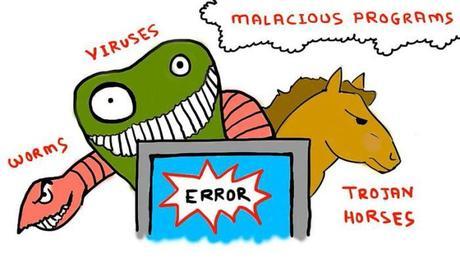
Image from By Berishafjolla (Own work) [CC-BY-SA-3.0 (http://creativecommons.org/licenses/by-sa/3.0)%5D, via Wikimedia Commons
Picture this. You switch on your computer or smartphone. And what you see on your screen is a warning that due to the discovery of illegal data on your device, all your data has been blocked and you need to pay a fine within the stipulated time to recover your data.
Now take this, the scenario is not a fiction but a reality many people have started facing around the world.
If you ever find yourself in a similar predicament, the good news is that your data has not been confiscated by any security agency. The bad news is that your device has been taken hostage by a malware.
This type of malware is called ransomware and it is a threat that is increasing day by day across the world.
And even worse news is that this is only one among the many different kinds of malware that are targeting the devices with increasing frequency. And it’s not just Windows computers that are getting attacked, but the malware threats are increasing for Mac devices and smartphones as well, especially Android smartphones.
As per the Threat Report H1 2014 brought out by F-Secure Labs, in the first quarter of year 2014, 277 threat families targeting smartphones were discovered. Out of these, 275 targeted Android devices. In second quarter, the number rose up even higher and as many as 295 threat families targeting smartphones were discovered. Out of these, 294 threats targeted Android devices and one targeted iOS devices.
Android devices are a prime target of mobilephone hackers because they are open source and because users of Android devices can easily install apps on their devices from any website, and are often tempted to do so when paid apps are offered for free. If you too go about searching the web for the free availability of paid apps, then beware! The free app that you download from third party sources might end up proving more expensive than the cost of the original paid app because you never know what some hacker might have bundled into this free version that your are downloading.
The threat of malicious attacks on computer and smartphones in India is increasing rapidly. And as the net connectivity and smartphone usage spreads across India, the threats and malicious attacks on unsuspecting users are going to increase too.
Already, India ranks 4th in the world in Mobile Malware attack. In India, the users of Chandigarh, Bangalore, Hyederabad, Chennai and New Delhi experience the most mobile malware attacks. However, the threats are spreading rapidly to other and smaller cities too.
The most prevalent kind of mobile malware are various kinds of Trojans that send high priced SMS to premium numbers, without the user’s permission and knowledge.
As per Goh, Su Gim, Security Advisor, APAC, F-Secure, “F-Secure research places India as a center for botnets – as bot infecting viruses like Ramnit and Sality are rampant. In the PC malware landscape, age old infection like Trojan.LNK and Conficker (Downadup) are still the highest. As per our research, top 5 most Infected Indian Cities in this order, Chandigarh, Bangalore, Hyderabad, Chennai and New Delhi. Furthermore, India ranks 4th in the world in Mobile Malware. Considering all these constantly increasing malicious activities, it is essential for users to be extra cautious and adopt optimum security solution.”
Also, cheap smartphones may end up proving too expensive too. F-Secure recently shared the research report which states that “Xiaomi phones send user data to remote servers“. Data snooping is almost becoming a trend with Chinese mobile makers.
But there’s more.
As per Sean Sullivan, Security Advisor of F-Secure Labs, “Details emerged earlier this year that paint a fascinating picture of crime-based malware evolving into espionage-ware. The bad guys out there are targeting far more that credit cards these days. Everything is of interest and there are likely a significant number of buyers for corporate data.”
Amit Nath, Country Manager, India & SAARC, F-Secure said, “Many incidents as highlighted in our Threat report shows that cybercriminals constantly adapt to new trends whether in by utilizing new malware or targeted attacks techniques to continue with their attacks. 2014 first half has highlighted many threats.”
So what you, as users of computer and smartphone devices, can do? Just follow the golden rule: prevention is better than cure. And prevention here includes not downloading media, apps etc. from insecure sources. Because if you do, the free stuff might end up proving too expensive.
Keep your devices protected with trusted security software. Beware and be sure of the source before your click links and download attachments.
And for more information about the malware being unleashed upon as at the moment, check the detailed Threat Report H1 2014 by F-Secure labs.
F-Secure, founded in 1988, is an online security and privacy company based in Finland and trusted by millions around the globe to protect themselves from online attacks. So check out their latest report, become aware of the kinds of malware getting unleashed on internet users across the world, and especially in India, and take all necessary measures to safeguard yourself.

